Microsoft Lumia 950 Review
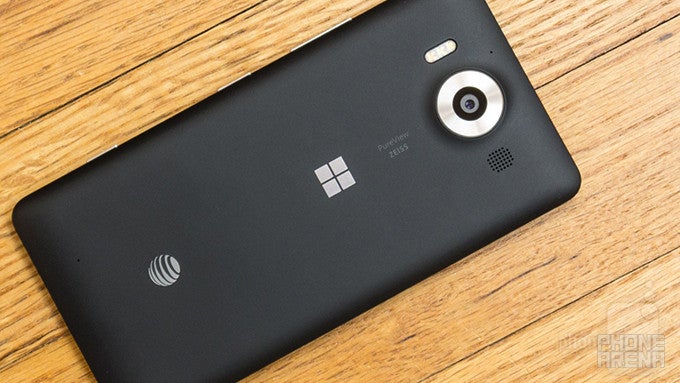
Introduction
Would you believe that it’s already been 5 long years since Windows Phone 7 launched? Back then, we saw several manufacturers jump on board in producing devices that showcased Microsoft’s mobile platform, but their impact on the market was marginal at best. Fast forward to the present day, and we only have a single entity leading the way – Microsoft itself.
With the launch of Windows 10, however, Microsoft has an ambitious undertaking – to reinvigorate the interest in its mobile platform. Could it be too late, though? Well, Microsoft begs to differ, as its Lumia 950 has launched to promote the full arsenal and capability of the company's most advanced mobile platform to date.
Entering the holiday season, we’re already seeing a handful of quality smartphones vying for supremacy, so there’s no denying that the Lumia 950 is attempting to penetrate a space that’s heavily saturated. Without question, Microsoft is a legitimate force to be reckoned with, but the Lumia 950 needs a solid, heavy hand to swing the tide in Microsoft’s favor.
The package contains:
- Wall Charger
- USB Type-C to USB Type-A cable
- Getting started guide
- Warranty Information
Design
It looks more like a prototype than a finalized product.
We’re a bit perplexed with the final decision regarding the handset’s design, mainly because the handset lacks the style and premium workmanship that many other phones of this class exude. It looks more like a rough, first-round prototype than something that has been meticulously eyed over. Seriously, Microsoft could have opted for a more attention-grabbing look, considering that design is what helps in gravitating prospective buyers to a particular device. The choice of materials, in particular, is what gives the Lumia 950 the feel of a lower-grade Lumia model. With its matte plastic body, one that’s offered in white or black, the phone lacks the visual appeal and substance to attract people – it feels somewhat hollow. Unlike previous phones like the Lumia 1520 or 930, with their stylish and angular designs, the 950 simply comes off dull and boring. It is not all bad news, however: in the hand, the handset feels lightweight and comfortable to hold. But in all fairness, if we’re to peruse the phones on display in a store, we’d certainly overlook the Lumia 950 because of its subdued presence and underachieving design.
As many previous Lumia models, the 950 features a dedicated shutter key on its right edge, and we do appreciate having it at our disposal. It gives us quick access to the camera app and comes in handy when snapping photos. Other notable design choices include the new USB Type-C port. As the connector is reversible, the charging cable conveniently goes in either way. But the new USB standard can make for a tougher time charging when you’re away from home, as the still dominant Micro USB cables don't fit.
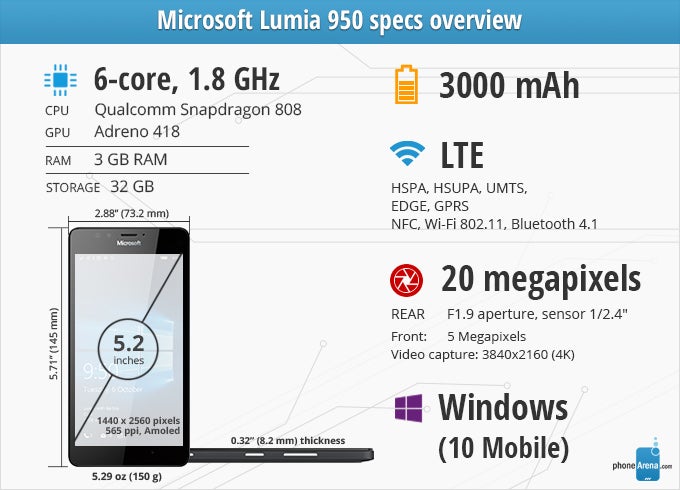
Display
Finally, a Windows-powered phone enters Quad HD territory!
At long last, Windows on mobile has ushered into the Quad HD era, and we’re gladly accepting of this reality. Keep in mind, though, that there’s really nothing that warrants the Lumia 950 more adulation over its rivals because Quad HD resolution been in circulation for quite some time now. With the Lumia 950, we’re given a 5.2-inch, 1440 x 2560-pixel AMOLED display with the reflection-reducing ClearBlack technology. Certainly, there’s no shortage of details with the screen's pixel-crushing 564 ppi pixel density.
Being of the AMOLED variety, the display exhibits all of the staple qualities of the technology – pure, deep black, fantastic clarity at wide viewing angles, rich contrast, and that unmistakeable glow in the dark. While our eyes tell us that we have a pleasant display here in the Lumia 950, the benchmarks help to validate that. Its color reproduction manages to accurately hit all of the target values in the sRGB color gamut chart. For all of its top-notch qualities, however, its luminance tops out at a mere 349 nits. That’s just underpowered by today's standards, which is why the Lumia 950 might be trickier to use under the sun compared to other recent high-end phones.
Pure and simple, there’s very little to complain about the Lumia 950’s display besides its weak brightness output. It’s just that, you know, we’ve seen Quad HD screens time after time in many other contemporary handsets.
Interface and Functionality
Windows 10 makes an evolutionary leap with Continuum.
The single most alluring aspect of the Lumia 950 is, undeniably, the new Windows 10 experience it’s delivering. Yes, Windows 10 is what Microsoft calls the software running on its handset, even though this is a Mobile version of the OS, not the Windows 10 tailored to run on PCs. Most people familiar with Microsoft’s mobile platform will notice that on the surface, the Windows identity is still present with this most up-to-date version. That, of course, is recognized just by looking at its dynamic Start Screen, which consists of those live tiles that make it distinctively Windows.
Microsoft’s mobile platform has evolved over the last several iterations, which now lays claim to a modest ecosystem filled with a healthy catalog of apps. It competes to some degree with Android and iOS, as many of today’s popular apps can be found in the Windows Store. Despite that, one of our biggest gripes about the platform is the fact that it lacks apps that are near and dear to Google users. Sure, you get a Google search app, but if you’re a diehard user of its other services, such as Google+, Google Voice, or Google Maps, you’ll be disappointed that you’ll find none of them for Windows 10. Even though Microsoft offers a YouTube “client”, it does nothing more than to open YouTube in the Microsoft Edge browser. Call it laziness, but we expect better!
On the flip side, the platform has its roots embedded in Microsoft’s ecosystem – so if it’s your cup of tea, you’ll be enthralled by its deep integration. And yes, you get the full suite of Microsoft Office apps out of the box, so it’s a productivity powerhouse right from the get-go. This integration is invaluable, just because we can start on typing up a document with Microsoft Word, then proceed to finish editing it over on a PC. The seamless integration moving from one Windows 10 device to another is useful, but something you’d kind of expect given that a lot of things are becoming cloud-based.
Trust us, there’s a lot to be excited about with Windows 10, but when we look at it from a practicality aspect, it still seems a smidgen behind the all-encompassing experiences we get from Android and iOS. Indeed, Microsoft makes some great strides here with Windows 10, which we’ll outline in more detail below, but it’s still by and large the third player playing catch up with the competition.
Windows Hello
Okay, the phone might lack a fingerprint sensor, but Microsoft offers its own alternative for unlocking the Lumia 950 – it’s called Windows Hello. Based on iris scanning technology, a red-colored LED light on the front of the phone turns on and works in conjunction with the front-facing camera to authenticate us. It work quite well, especially when we improve the recognition by running the process through several different light sources.
Continuum
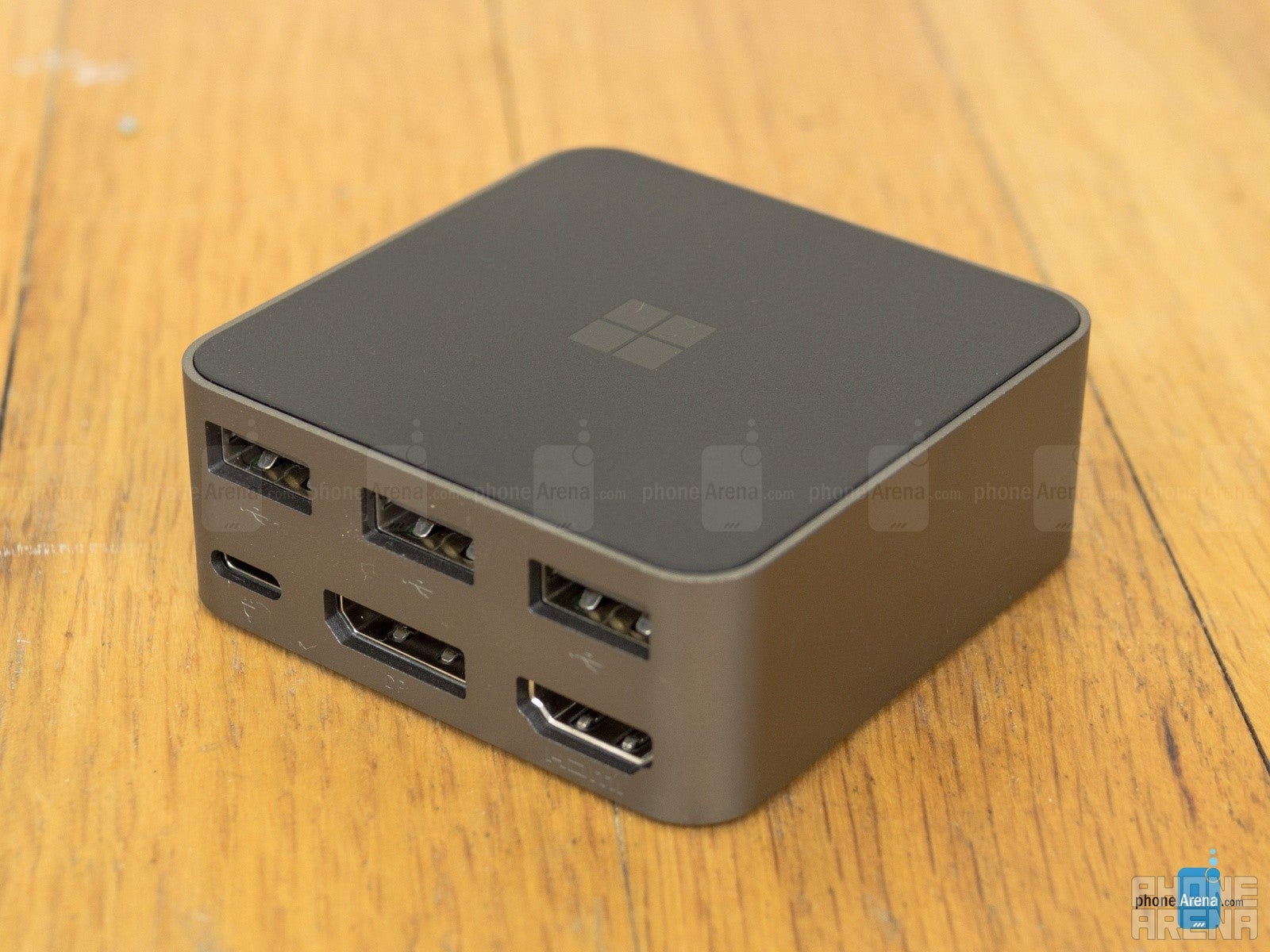
The Display Dock accessory
There are two ways of using Continuum. The first requires the Display Dock accessory, a puck-shaped device that enables us to connect an external monitor, mouse, keyboard, and other USB-based peripherals to it. Conversely, if you happen to have a Miracast-enabled monitor or dongle, you can experience Continuum in a wireless way. Of course, between the two, the Display Dock provides us with a more responsive experience, seeing that the Miracast route can sometimes be hindered with latency issues – albeit, it still works quite well.
Once Continuum is enabled, we get an experience similar to using Windows 10 on the connected monitor. In fact, it reminds us of the Windows 10 experience on a tablet, while the phone itself can become the mouse cursor. All of the native apps, including Microsoft’s Office apps on the Lumia 950, run almost identically to what we get from a traditional laptop or desktop running Windows 10. This is all fascinating, but at the same time, makes for an added benefit because we’re presented with an environment that allows us to get work done more easily. The limitation with it, though, is that we can’t have two applications running side-by-side, but we can at least switch between the ones were using at any time.
The biggest obstacle thus far for Continuum, however, is the fact that very few third party apps have been converted to the Universal Windows Platform – they’re apps that have been optimized to run on all sorts of devices (laptops, desktops, tablets, smartphones, etc). You can instantly tell what apps on the phone aren’t Universal apps because they’re shaded out. And this is a brick wall for now, mainly because the Continuum feature is isolated to Microsoft’s stable of apps – and a very few select third party ones. For some strange reason as well, many of the Lumia branded apps aren’t supported by Continuum.
Messaging
We’ve always been fond with the typing experience on a Windows Phone, so we can continue saying the same thing here with the Lumia 950. The layout hasn’t changed all that much, as well as its responsiveness, prediction, and auto-correct functionality, but now there’s this green dot on the keyboard that allows us to precisely place the cursor. The implementation works rather well, and beats having to finagle trying to position the cursor ourselves with our finger.
System Performance
It’s quick and responsive, but apps have a notorious way of constantly refreshing.
Very few Windows Phones in the past have been regarded as high spec’d when they’re compared to their Android counterparts. Sure, there are a few that certainly qualify, but the vast majority didn’t need to be, just because Microsoft has one optimized platform already. As for the Lumia 950 in particular, it’s sporting some agreeable hardware – a hexa-core 1.8GHz Qualcomm Snapdragon 808 chipset that’s accompanied with the Adreno 418 GPU and 3GB of RAM.
Not surprisingly at all, the Lumia 950 runs smoothly with all sorts of tasks – including Continuum, which requires the extra horsepower because we’re dealing with a very desktop-like experience. Our only qualm with the performance is how several apps are constantly being refreshed whenever we exit and come back to them. It’s quite maddening, especially when we’ve spent a deal of time scrolling to a particular section in an app, to only find it refreshing and bringing us back to where we first started.
Camera
The camera reputation is intact with the Lumia 950, but we’ve seen better performing stuff already.
Lumias have been notable for their photo-taking abilities, so the reputation is unchanged here with the Lumia 950. The phone is endowed with a 20-megapixel, 1/2.4” camera sensor with Zeiss optics. This particular configuration breaks down to a 6-element, f/1.9 aperture lens, optical image stabilization, BSI, and an unprecedented triple LED flash. It’s also quite diversified with its video recording package, offering us all sorts of resolutions consisting of 720p, 1080p, and UHD 4K at various frame rates.
The camera interface hasn’t changed a bit, which is both good and bad at the same time. Over on the good, its interface is still a favorable one because of the tight manual controls it offers – giving us access to white balance, focus, ISO, shutter speed, and exposure adjustment. Conversely, however, we’re still required to install various ‘lenses’ for additional shooting modes. While it boats the lines’ signature Rich Capture mode, an HDR of sorts, it doesn’t have a native panoramic mode.
Image Quality
Much like the vast majority of quality phones out there, the Lumia 950 dishes some pleasant-looking shots when the lighting conditions are ideal. But the details that it captures aren’t as clear as what some other cameras produce, despite its 20-megapixel count. Also, colors tend to be a bit oversaturated, giving the image an unrealistic look.
Well, that unnatural effect becomes more profound when we switch over to its Rich Capture mode. To be fair, though, it’s able to cast an even exposure throughout the shot, so that shadows and highlights are well-represented, but in doing so, there’s a significant boost to its color saturation and contrast. The end result looks more artificial than anything, since photos tend to have a pronounced glow to them due to the post-processing.
Under low light, the Lumia 950 undoubtedly has its strong characteristics. At the very least, the increase in exposure helps to draw out details – while digital noise is thankfully minimized in the process. For low light scenes that have a lot of movement or action, there’s a higher chance of photos coming out blurred due to the longer exposure. Regardless, we’re satisfied with its performance. The triple LED natural flash also lends its usefulness in giving shots balanced lighting, without having too much of an overpowering presence in the shot.
Video Quality
The Lumia 950 performs well when recording video in settings with ample lighting. Naturally, UHD 4K delivers the best results when it comes to details, as its 1080p samples appear a bit softer toned, but its exposure adjustment tends to be a bit too sensitive all around. Audio recording is decent, but the phone has troubles with wind reduction.
Under low light, there’s more presence of noise in the footage, and when you combine that with its smudgy details, it doesn’t really make for a compelling performance. Still, the built-in optical stabilization manages to keep things steady.
Multimedia
Same old, same old.
Sporting a fairly large AMOLED panel with good color reproduction, the Lumia 950 makes for an ideal choice when it comes to watching videos – especially how videos just come to life thanks to the qualities of the screen. But while it’s more than capable of playing all sorts of resolutions and codecs, Windows 10 still lacks that multi-tasking element wherein videos can be ‘minimized’ and overlaid over whatever else we’re doing on the phone.
By now, any Windows user will know that music playback is by default handled by the Groove Music app, which not only allows us to play native content on the phone, but also streaming content courtesy of Groove Music Pass – a subscription service very much like all the others out there. Visually and functionally, it doesn’t deviate from what we’re exposed to on rival music players.
Having only a single speaker, positioned next to the camera lens, it musters up a respectable 76.5dB of audio power. The quality is easy on the ears, as it churns out enough substance at the loudest volume without sounding strained. Fortunately, if its default quality isn’t to your specification, it can be fine-tuned by adjusting the equalizer in the phone’s settings – it’s not accessible through the Groove Music app regrettably.
Battery
Although it’s an average performer with its battery life, it’s the fastest-charging Windows based smartphone to date.
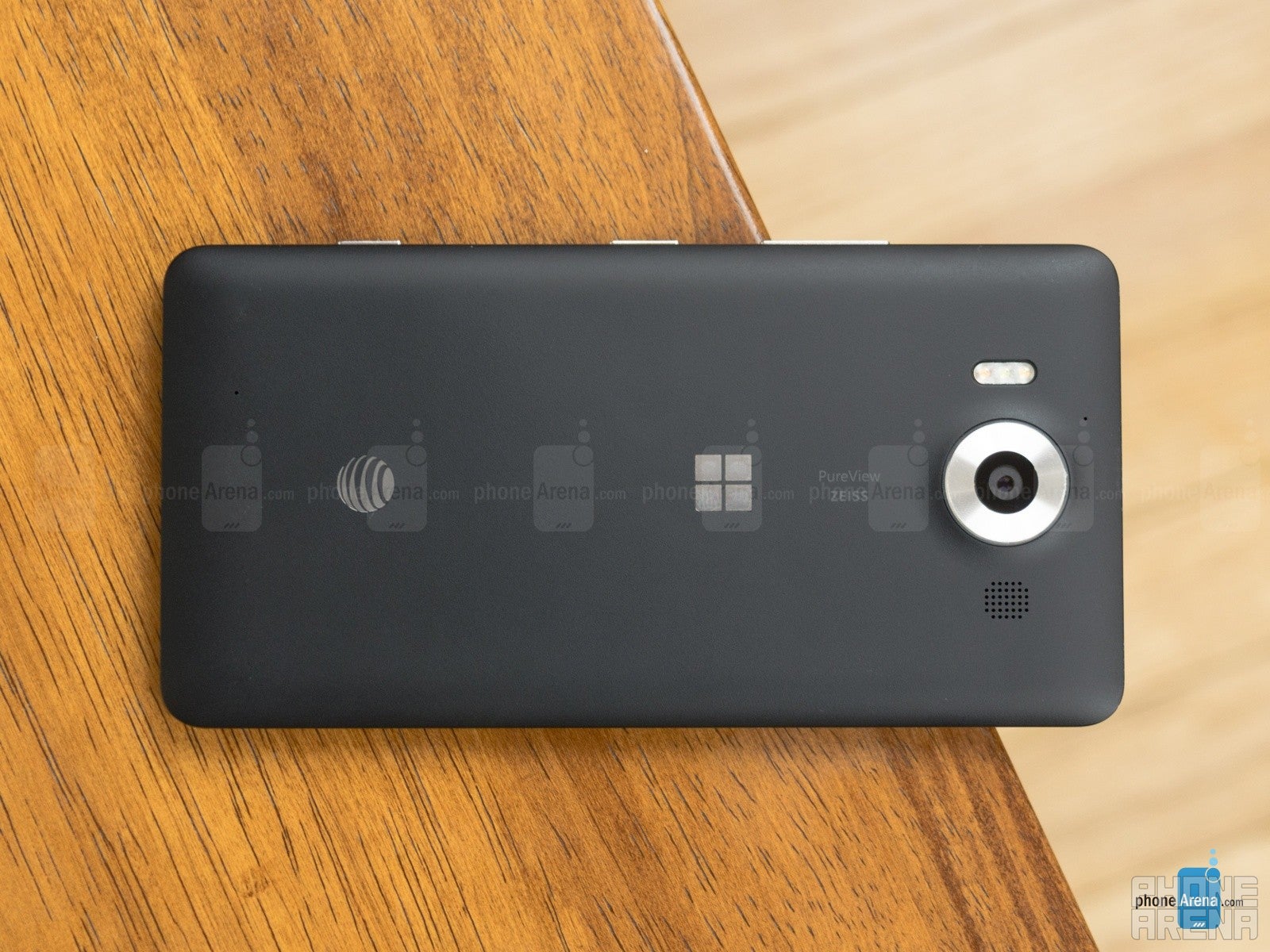
Using the included USB Type-C wall charger, the Lumia 950 coughs up a better-than-average recharge time of 93 minutes – making it the fastest charging Windows running smartphone we’ve come across to date. That tally also rivals many of the greats around right now, like the Motorola DROID Turbo 2 and Google Nexus 5X, but it’s been blessed with wireless charging as well. Therefore, any Qi compatible wireless chargers will work with it.
Conclusion
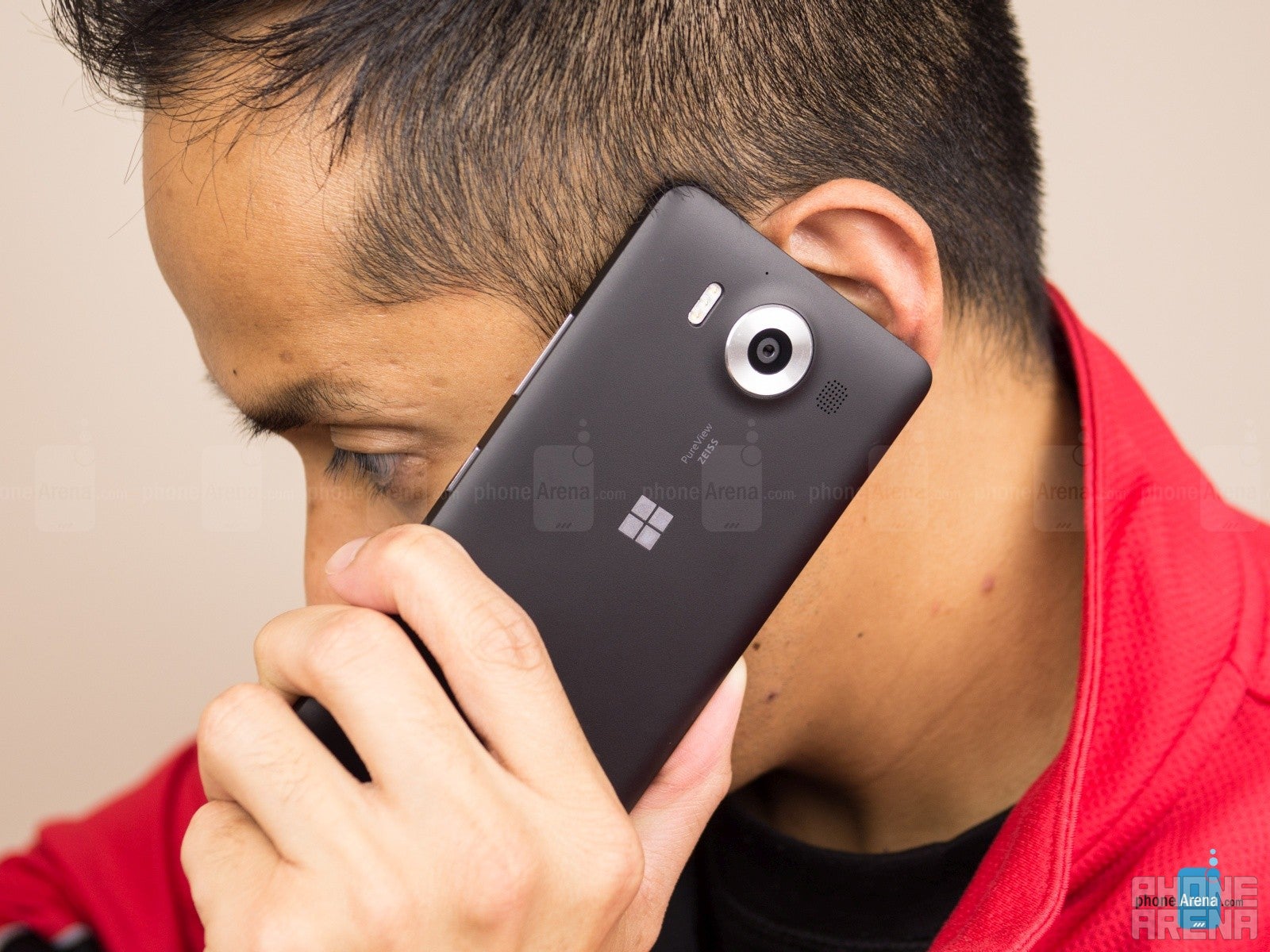
Essentially, it’s a bridge smartphone to help tide them over in the meantime, until something bigger, more ambitious comes to fruition. At the same time, the Lumia 950 could be a suitable device for those who are looking for a different experience or those who are just making the move to a smartphone.
On the downside, the phone's price point and exclusivity with AT&T mitigates its potential in being a top contender in the space. Out of the gate, the Lumia 950 carries an outright price of $598.99 – or $149.99 with a 2-year contract through AT&T. Granted it has the specs sheet to warrant its price point, the design surely makes it feel underwhelming in comparison to other phones in the same caliber.
In addition to its pricey cost, its exclusivity with AT&T won’t help Microsoft spread the good word about its new Windows 10 experience. That’s a huge limitation considering the customer base it’s missing out on by not being available on other carriers. All of this again paints to a picture of it being a tide-over device, something that only diehard Windows fanatics will appreciate.
Don’t get us wrong, it has the specs and performance to satisfy buyers who have been heavily invested in the Windows ecosystem, but it’s just not that halo Windows 10 smartphone that can compete with the likes of the iPhone 6s, Galaxy S6, or Nexus 6P – it just isn’t. We’re really impressed by what Microsoft is doing with the platform and with Continuum's functionality, but we surmise that something bigger, more flagship-worthy will one day or another come to light. This isn’t it, that’s for sure.
Software version of the review unit: Windows 10 Mobile
OS build: 10.0.10586.0

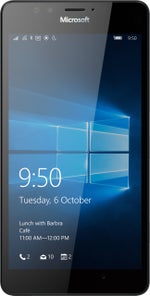
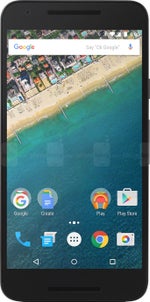
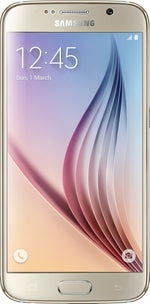
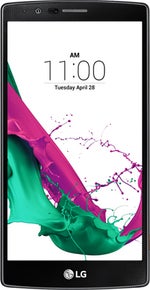




























Things that are NOT allowed: